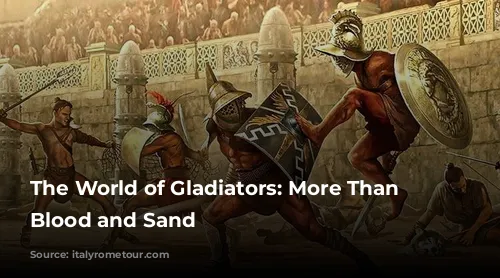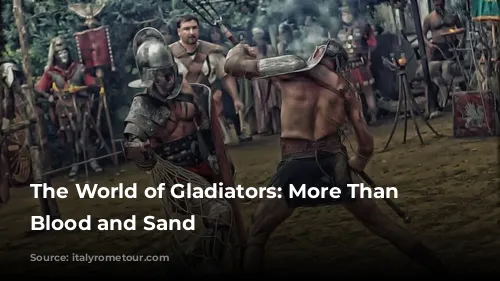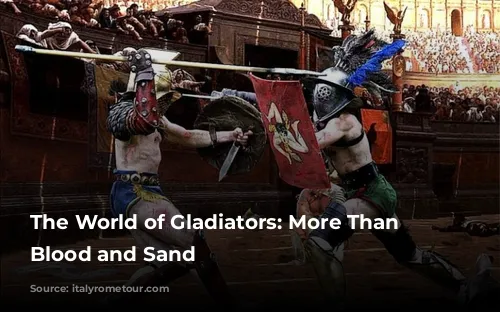Imagine the roar of the crowd, the clash of swords, the smell of sweat and blood. This was the daily reality in the Colosseum and other amphitheaters across the Roman Empire. But who were these gladiators who fought for their lives, and what truly happened in these arenas?

From Etruscans to the Colosseum: The Rise of Gladiator Games
The tradition of gladiator combat has roots in the Etruscan culture, a civilization that preceded the Romans. Just like many other Etruscan practices, the Romans embraced the spectacle of gladiatorial duels.
The first recorded gladiator show took place in 264 BC, and by 105 BC, these games were open to the public. These shows quickly became a central part of Roman life, providing entertainment and a glimpse into the brutality of the times.

The Gladiator’s Life: A World of Discipline and Danger
Gladiators were a diverse group, ranging in age from 20 to 35, with an average height of 168 cm. They could be professional fighters, inexperienced newcomers, criminals, slaves, prisoners of war, even Christians – all vying for survival in the arena.
These fighters were trained in special schools like the renowned Ludus Magnus, where they lived in cells arranged according to their skill level. Under the guidance of a magister, they underwent rigorous daily workouts and followed a diet rich in vegetables, legumes, honey, and dairy products. They even ate a honey focaccia before entering the arena for an extra boost of energy.

The Arena: A Spectacle of Skill and Brutality
Each game began with a grand parade. First, the financier entered, followed by attendants carrying signs displaying the day’s program. Slaves carried the weapons for the fighters, and then came the gladiators themselves, along with those sentenced to death. After greeting the emperor, the fighters prepared for battle.
Different types of gladiators existed, each with their own unique weapons and fighting styles. The Mirmillone wore heavy armor, including a helmet and shield. The Thrace wielded a curved sword and a small shield. The Secutor, meaning “pursuer”, was also heavily armored and known for chasing down his opponent. Finally, the Retiarius relied on a net, dagger, and trident, making him the lowest class of gladiator as he fought only in a tunic. However, he was a popular favorite because the crowd could see his face.
The fate of a defeated gladiator rested in the hands of the crowd. With a simple thumb gesture, they could decide whether the fighter lived or died. A thumb pointed up (“mitte”) meant life, while a thumb pointed down (“jugula”) signified death. Ultimately, however, the emperor or the show organizer held the final say.
The games were not just about brutality. Many mythological episodes and grotesque situations were staged, adding a theatrical element to the violence.

Beyond Gladiators: The Venationes
The games were not limited to human combat. Venationes, fights between gladiators and wild animals, were equally popular. Lions, tigers, leopards, elephants, bears, deer, wild goats, and camels all graced the arena, with the lion being particularly favored for its ferocity.

The Legacy of the Gladiator: From Shame to Legend
The life of a gladiator was difficult and dangerous. They fought for their lives, their freedom, and for glory. The Roman people admired their strength and courage, elevating the victorious gladiators to celebrity status.
Many gladiators were slaves or former slaves, but free-born individuals could also join the ranks under contract. Often viewed as outcasts, prostitutes, actors, and pimps, they were labeled “infames” – people of bad reputation.

A Reality of Skill and Brutality: Redefining the Gladiator
Recent studies based on the analysis of gladiator skeletons have shown a different side to these fights. The wounds suggest that the battles were not mere massacres, but rather organized wrestling matches with precise rules.
Helmets, although sturdy, did not protect completely, as wounds were found on 10 skulls. These injuries likely resulted from hammer blows, suggesting that some gladiators, after losing, were executed by the public or notables. This grim reality paints a picture of an inglorious end for some of these fighters.

The Colosseum: The Empire’s Greatest Arena
The popularity of gladiator shows skyrocketed during the Roman Empire. The Flavian dynasty built the Colosseum, the largest and most famous amphitheater in the world, a testament to the empire’s fascination with these spectacles.
However, with the rise of Christianity, Emperor Constantine I banned gladiator games in the fourth century. Despite the negative stigma associated with gladiators, they remained sex symbols of their time, captivating the hearts of many, including nobles who willingly abandoned their husbands for the love of these heroes.
The world of gladiators was a complex one, filled with both violence and spectacle. They were not simply brutal killers but also skilled athletes, trained warriors, and sometimes even reluctant victims. While their lives were filled with danger and hardship, their stories continue to fascinate us, offering a glimpse into a bygone era of the Roman Empire.
